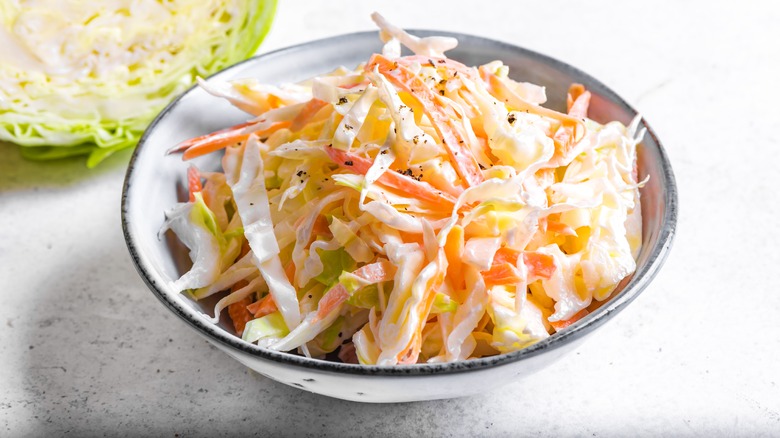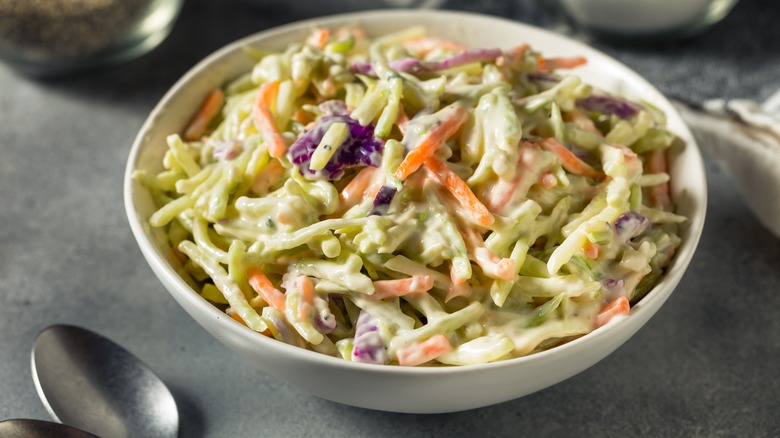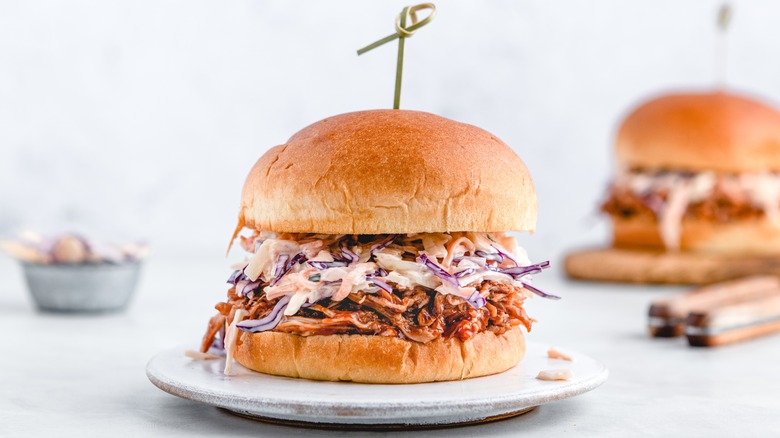Let's Get To The Bottom Of This: Is Coleslaw A Salad Or Condiment?
All right, coleslaw — what's your deal? How do we categorize you at the potluck? No one contests that this cabbage-based concoction is a side dish, but would it be better classified under salads or condiments?
Let's start with salad, defined by Merriam-Webster as "raw greens... often combined with other vegetables and toppings and served especially with dressing." Coleslaw certainly fits the bill for that, almost to a T.
Though it can be served and enjoyed separately, there are plenty of people who enjoy using coleslaw to top their pulled pork sandwiches, hamburgers, or even hot dogs. Bright, crunchy slaw mixed with the meaty, smoky richness of barbecue: What could be better? The definition of a condiment, according to Merriam-Webster, is "Something used to enhance the flavor of food." By that definition, any number of things could be considered a condiment, with coleslaw certainly one of them.
The verdict? It's a little of both, depending on how you use it. If you're in the "on the side" camp, you might see it primarily as a salad; if you can't enjoy your sandwich without that bit of crunch and tang, you might be in the condiment camp. One thing's for sure: There's no right or wrong way to enjoy this classic summer side dish.
Coleslaw's international origins
Despite it being a standard dish at American barbecues, coleslaw actually originated in the Netherlands. The word coleslaw comes from the Dutch koolsla, which translates to "cabbage salad." Original versions of the dish likely were made with a vinaigrette that would lightly pickle the vegetables.
The concept of coleslaw was brought to the United States by way of New York, ferried in by Dutch settlers in the 1700s. The advent of mayonnaise in the mid-1700s added an essential ingredient that helped the dish evolve to its current iteration. Over time, it became an irreplaceable component of Southern barbecue culture.
While recipes vary, with some including fruits, seeds, cheeses, and various other mix-ins, coleslaw at its base contains just a few ingredients: shredded cabbage, carrots, and a dressing (typically a creamy coleslaw dressing made with mayonnaise and/or vinegar). Various cultures have their own spin on the dish, including kraut salad in Germany and veckosallad in Sweden.
Coleslaw variations for your next potluck
Love coleslaw, but want to punch up your offerings at the next potluck? With the blank slate of shredded cabbage as your base, the possibilities are infinite. Try adding some nuts such as pecans or walnuts for crunch, or other chopped or shredded vegetables like radishes. Dried or even fresh fruits can add a burst of color and flavor. Some folks even add a sprinkle of cheese — feta, parmesan, or even blue cheese all work well, depending on what flavor profile you're going for. Just be sure to choose a dressing that works well with the medley of flavors and include a contrast of textures.
Coleslaw doesn't have to be just a sandwich topper or a rib side dish, either. Try it under grilled steak, alongside roasted chicken, or accompanying perfectly fried fish. Whether you're slathering it on top of your main dish or eating it on the side, whatever you call it, coleslaw truly can't be beat.


